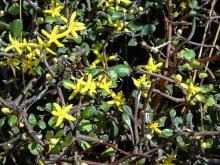David Quote :"It is a good example of a divaricating shrub ie the branches are all entangled. I am fairly certain it is a New Zealand native called Corokia cotoneaster. It will produce yellow star-shaped flowers which are quite attractive followed by red/orange berries.
I have found a picture of the plant in flower which I am attaching"




It is a good example of a divaricating shrub ie the branches are all entangled. I am fairly certain it is a New Zealand native called Corokia cotoneaster. It will produce yellow star-shaped flowers which are quite attractive followed by red/orange berries.
I have found a picture of the plant in flower which I am attaching